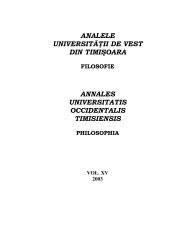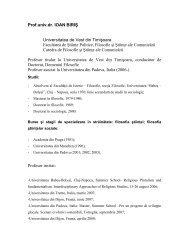VOL. IV (XXI) 2009 - Departamentul de Filosofie si Stiinte ale ...
VOL. IV (XXI) 2009 - Departamentul de Filosofie si Stiinte ale ...
VOL. IV (XXI) 2009 - Departamentul de Filosofie si Stiinte ale ...
Create successful ePaper yourself
Turn your PDF publications into a flip-book with our unique Google optimized e-Paper software.
64 “FICTION” AND “MODEL” IN SCIENTIFIC KNOWLEDGE<br />
In the following survey two distinct modalities of legitimating the role of<br />
the imaginary in the scientific knowledge- the one sustained by Hans<br />
Vaihinger and the one that belongs to Max Black and Mary B.Hesse- are<br />
submitted to critical approach, in or<strong>de</strong>r to highlight certain theoretical<br />
<strong>si</strong>milarities, essential to contemporary epistemology.<br />
I. Obviously, H. Vaihinger has produced one of the first attempts at<br />
systematic approach of the role of the Imaginary in the scientific knowledge.<br />
His work Philosophie <strong>de</strong>s Als Ob (1911, translated into English as The<br />
Philosophy of As If, 1924) is usually appreciated as playing an important part<br />
in the contemporary epistemology’s en<strong>de</strong>avors 2 to recover the scientific<br />
imaginary.<br />
The imaginary or fictional aspect of scientific knowledge is approach by<br />
the German philosopher from the point of view of mental structures as being<br />
a product of the logical functions, an aspect of the “reasoning capacities” 3<br />
and not a product of intuition as one may be tempted to believe. Since the<br />
concept of mo<strong>de</strong>l was not broadly used in contemporary science, Vaihinger<br />
named mo<strong>de</strong>ls “schematic fictions”. He distinguishes two types of imaginary<br />
constructs: “half-fictions” and “authentic fictions”. The first type of fictions<br />
oppose/contradict given reality without contradicting themselves (for instance<br />
the artificial categories) and in this case we speak only of a “material<br />
<strong>de</strong>viation” whereas the “authentic fictions” are contradictory in relation with<br />
reality as well as with themselves, to the extent where they do not<br />
correspond to the logical principles of i<strong>de</strong>ntity and contradiction (for instance,<br />
the concept of atom). Stating that cognitive processes and constructs must<br />
be con<strong>si</strong><strong>de</strong>red from the point of view of their intentional function, the author<br />
will arrive at proclaiming the pragmatic status of fictions.<br />
Scientific fictions assume this aspect because their use is almost each<br />
and every time doubled by the certainty of the fact that fictional i<strong>de</strong>a, fictional<br />
presuppo<strong>si</strong>tion “is not really valid” 4 .<br />
Vaihinger in<strong>si</strong>sts on that the object of the scientific en<strong>de</strong>avor is to build<br />
up i<strong>de</strong>as which respond to the types of scientific reality hence eliminating any<br />
2<br />
Recent authors have been exploring the implications of Vaihinger's philosophy on<br />
fiction: Wolfgang Iser, The Fictive and the Imaginary: Charting Literary Anthropology<br />
(Baltimore: Johns Hopkins Univer<strong>si</strong>ty Press, 1993), Daphna Erdinast-Vulcan, Joseph<br />
Conrad and the Mo<strong>de</strong>rn Temper (New York: Oxford Univer<strong>si</strong>ty Press, 1991);<br />
Jaqueline Vaught Brogan, A Theory of Language (Princeton Univer<strong>si</strong>ty Press, 1986);<br />
A<strong>de</strong>na Rosmarin, The Power of Genre (Minneapolis: Univer<strong>si</strong>ty of Minnesota Press,<br />
1985). One of the most interesting applications of Vaihinger’s concepts is most<br />
certainly that presented within the work of the American psychologist James Hillman<br />
– Healing Fiction (1994) – where the author state that in the <strong>de</strong>scription of certain<br />
psychological conditions (neuro<strong>si</strong>s and madness for instance) fictional constructs are<br />
used (psychological fiction) which represent literalization ten<strong>de</strong>ncies rather than “see<br />
through our meanings” (HF, p. 110)<br />
3<br />
Vaihinger, H., Filozofia lui „Ca şi cum”, Bucureşti, Editura Nemira, 2001, p.60<br />
4<br />
Ibi<strong>de</strong>m, p.148




